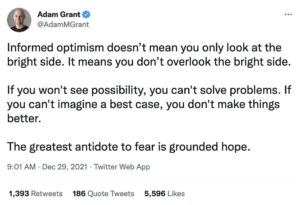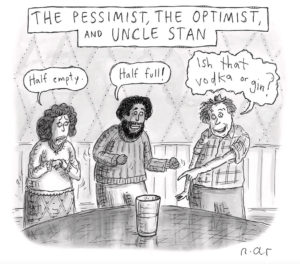“It’s just bleak out there.” My patient was referring to the weather and also her general outlook. “Bleak” captures the way many people are feeling right now—general malaise, emotional exhaustion, and overwhelming pessimism. I just read about a group of moms who met up on a frigid night in Boston to voice their collective exasperation. They stood in a socially distanced circle and screamed into the darkness.
Those moms are all of us—stuck in a bleak midwinter, drained by the daily grind, unsettled by all the uncertainty, frustrated by the fluctuations of hope and despair.
While there are certainly plenty of reasons to be downbeat, don’t let defeatism defeat you. When all we see is doom and gloom, we lose agency and hope. As organizational psychologist, best-selling author, and fellow Bulletin writer Adam Grant tweeted:

Here are 5 strategies to help you cultivate grounded hope and realistic optimism:
1. Your Best Possible Self
Imagine yourself in a future where everything has gone right. You’ve worked hard to achieve the realization of your dreams and accomplish your goals. In other words, you’ve become your best possible self. What would your life look like? How would you spend your time? Who would be by your side? The best possible self exercise is a research-supported intervention for improving mood and increasing optimism.
2. Question Your Assumptions
When feeling stressed out, we tend to interpret adverse events as personal, pervasive and permanent. For instance, you spill your morning coffee and automatically engage in a negative thought pattern: “I’m an idiot. Today is going to be a terrible day. Why does this always happen to me?” When we attribute disappointments to internal and fixed factors, we feel hopeless and helpless. Challenge this pessimistic outlook by questioning the three P’s. When you encounter a setback, ask yourself:
Is this Personal?
Is this Permanent?
Is this Pervasive?
Disputing automatic negative thought patterns will help you see the situation more realistically.
3. Seek Silver Linings
Benefit-finding, the act of actively identifying positive ways one’s life has changed as a result of a stressful situation or event, fosters positive coping and orients people to the presence of protective factors in their lives, such as skills, strengths, or resources that can help them deal more effectively with difficulty. Research on resilience during the pandemic published in Frontiers of Psychology found that benefit-finding was associated with reductions in psychological distress and helplessness. It is likely that silver linings such as finding a sense of community, experiencing gratitude, and recognizing that the pandemic may spur positive social change served as psychological buffers. Cultivate psychological buffers for yourself and guard against noxious negativity by asking yourself, “What’s good?” If we exclusively focus on the negative, we deny what’s possible.
4. Find Middle Ground
Michael Montaigne once said, “There were many terrible things in my life and most of them never happened.” Catastrophizing comes naturally to many of us but is rarely a productive use of our mental energy. To counteract this doomsday mindset, Martin Seligman, the founder of Positive Psychology, suggests a simple exercise called ‘Put it in Perspective.’
Step 1: Play out the worst case scenario
Step 2: Play out the best case scenario
Step 3: Consider what’s most likely to happen
Between the two extremes, you’re more likely to find the most realistic outcome.
5. Model Realistic Optimism
According to a recent paper published in the Journal of Positive Psychology, many parents assume incorrectly that teaching their children that the world is a bad place is best for them. In fact, 92% thought that seeing the world as safe to very safe will not prepare their children to navigate the world. Many parents expressed the belief that their children would benefit by being taught to see the world as declining, competitive, fragile, unjust, barren, not funny, and full of physical threats. The findings suggest otherwise. People with more negative beliefs about the world were found to be less healthy, suffered more frequent negative emotion states, were more likely depressed, were much less satisfied with their lives, and enjoyed dramatically less psychological flourishing. As the researchers concluded parents might consider pausing any well-meaning efforts to inculcate such negative beliefs in their children.
While we may be surrounded by bleakness, there is a case to be made for realistic optimism. I greatly appreciated Molly Jong-Fast’s uplifting reminder that It Won’t Be January Forever.
Time ticks away, seasons blend into each other, the warm weather will come back, days will get longer. There will be melting ice-cream and eating outdoors, and the warm sun on your shoulders. There will be walks in the park and movies and puppies. It won’t always be this gray.
This isn’t toxic positivity. It’s deliberate optimism. And it’s just what the doctor ordered.
 “The Pessimist The Optimist” by Roz Chast / New Yorker Cartoons
“The Pessimist The Optimist” by Roz Chast / New Yorker Cartoons
I wish you all the best,
Dr. Samantha Boardman







